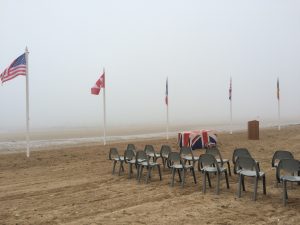In the original 1960s Charlie Brown Christmas special, Charlie Brown laments that Christmas has become too commercial—so much so that even his dog Snoopy is participating in a lights and display contest. I was reminded of that when looking at many of the products on display in Normandy in different gift shops over the last few days. I would generally hold to the principle that if a particular product would be in bad taste if offered in relation to the September 11, 2001 terrorist attacks, it is probably inappropriate to have for D-Day. While one can respect that tourism is a major industry in this area, there is something off-putting about seeing so many products about an event where so many men died. It is one thing to have T-shirts that say “I survived D-Day,” but when you see stores offering posters with scantily-clad cartoon pin-up girls superimposed over images of the battle, the line of good taste has already been crossed. Seeing such things, one might ask for someone to come out and explain what D-Day is about, just as Linus did for Charlie Brown.
However, today we attended a number of different D-Day ceremonies, and these came closer to capturing the truth of what the day means. We attended two local ceremonies on the beaches in the morning. The first one included a wreath-laying and different poem recitations; in the second one, small crosses were laid on the sand. This ceremony was effective (and more religious than its predecessor), although when we listened to the national anthems of Britain, Canada, and France, there were audio problems with the French anthem. At the much-larger ceremony in front of the Canadian museum for Juno Beach, wreaths were also laid, but the most effective part involved the living veterans who were brought out and each given ovations from the audience. After the ceremony, we got in line to shake their hands. One of them said to me he hoped that June 6, 1944 had been worth it. It was like a challenge.
We also attended ceremonies at a graveyard for Canadian soldiers in Normandy. Small Canadian flags were placed at all the headstones, but most of them were put there by locals from France who appreciated what the Canadians did. Then, in the last ceremony of the night, all the attendees were given symbolic flowers to toss into the waters on the beach. That was an emotional experience for many people in attendance.
While these ceremonies were moving, one image from that day does not come from any of them. But it does capture the meaning of this day. The final late night ceremony did not start until 10:00 pm, so we had some time to pass before that, and during this time, around 9:15 pm, I took a look at the beach. At that time of night, it was still light outside, although the sun was setting. The tides on Juno beach were quite far out. You could walk over the sand and seaweed a great distance before reaching the water. Before the tide returned to the shore, I saw a large number of French children had gone out into this area and were playing on the sand and laughing.
Seventy-two years after Canadian soldiers fought and died in that exact place, French children were playing there in the sunset.
I think if Charlie Brown had asked Linus to explain the meaning of D-Day instead of Christmas, a description of this image would have done the job. We remember the sacrifice of these Canadians who enabled the children of France to have that freedom.
By Robert Revington

